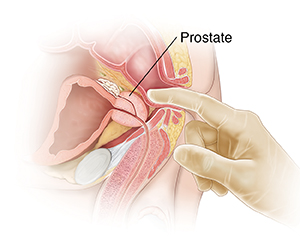Prostate Cancer Screening
The prostate is a gland that lies just below the bladder. It wraps around the urethra, which is the tube that carries urine and semen out of the penis. The prostate is part of the male reproductive system. It makes fluid that's part of semen.
Problems with the prostate tend to become more common as a man ages. These problems include prostate cancer, a common cancer in men. Screening tests are used to help find cancer early. This is when it's small, hasn't spread, and isn't causing symptoms.
Prostate cancer doesn't cause symptoms in its early stages. So screening tests can often help find prostate cancer early. But not all cancer experts agree that all men should be screened. This is because screening can lead to serious problems. For instance, it can find cancer that may not need to be treated. This can lead to stress. It can also lead to major side effects from treatment that may not have been needed. These include erection problems and trouble controlling urine flow. Most experts agree that men should talk with their healthcare providers about the pros and cons of screening before it's done.
What is prostate cancer?
Prostate cancer is the out-of-control growth of changed (mutated) prostate cells. These cells don't look, act, or work the way they should.
Prostate cancer starts in the prostate. But over time, it can grow and spread to other parts of the body.
Risk factors for prostate cancer
Things that can increase a man’s chance of prostate cancer are called risk factors. These include:
-
Age. As you grow older, your risk of prostate cancer increases.
-
Family history. If your father or brother has had prostate cancer, your risk is higher.
-
Race. African-American men are more likely than other men to develop prostate cancer. They're also more likely to die from prostate cancer than white men with this disease. The reasons for this are not clear.
Screening for cancer
Screening for prostate cancer can help find cancer before it causes problems. The screening tests most often used are a digital rectal exam (DRE) and a prostate specific antigen (PSA) blood test.
Talk with your healthcare provider about the pros and cons of regular screening starting at age 50 if you are at average risk for prostate cancer. Have this talk at age 40 if you are at higher risk because of your risk factors.
Before your screening test
If you decide to be screened for prostate cancer, be sure to tell your healthcare provider about:
-
Health problems you have
-
Family members who have had prostate cancer or other cancers
-
All medicines, herbs, vitamins, and supplements that you take
-
Problems with urination or symptoms of urinary tract infection
Digital rectal exam (DRE)
Your healthcare provider may perform a DRE. This is done by gently putting a lubricated gloved finger into your rectum to feel the surface of your prostate (which is right next to your rectum). It's quick and doesn't hurt. Many prostate problems can be found with this exam.
 |
| The DRE takes just a few seconds. |
PSA test
PSA is a protein made by prostate cells. Your PSA level can be measured with a blood test. A PSA level that's high or has been going up over time may be caused by prostate cancer. But it might also be caused by another problem that's not cancer. A lower PSA level means that cancer is less likely.
If your total PSA test results aren't normal, your healthcare provider may also check:
-
Percent-free PSA (fPSA). This is the ratio of free PSA to total PSA. Free PSA is PSA that's not bound to certain proteins in the blood. A lower percent-free PSA means a higher chance of having prostate cancer.
-
Prostate health index (PHI) or 4Kscore test. These combine the results of different types of PSA to get a score showing the likelihood of a man having prostate cancer.
-
PSA velocity. This is how fast the PSA level is rising over time.
-
PSA density (PSAD). This is the relation of the PSA level to the size of the prostate.
Many factors can affect PSA levels. These include age, an enlarged prostate, certain medicines, some supplements, and prostate cancer. Other factors can cause short-term PSA changes, like a prostate infection or recent sex. Your healthcare provider can explain how these factors may affect the timing of the PSA test and your results.
Other testing
Here's the problem with prostate cancer screening: Problems found with DRE may not be tumors. And a high PSA level does not always mean cancer. So more tests may needed. These may include:
-
Repeat PSA test. You may wait a while and then have another PSA test done.
-
Different PSA test. Other types of PSA tests (as covered above) might be done to get more detailed information.
-
Imaging tests. If cancer is suspected, imaging tests might be done to help look for changes inside the prostate. Ultrasound and MRI scans can find changes that might be prostate cancer.
-
Biopsy. This test takes tiny pieces of tissue (called samples) from the prostate using a thin, hollow needle. An imaging test, like ultrasound or MRI, is used to help guide the needle to the right place in the prostate. The tissue samples are then tested in a lab for cancer cells.